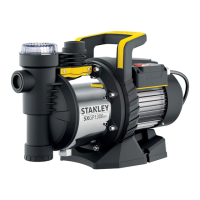10 11
(Translation of the original instructions)
© 2017 English
(Translation of the original instructions)
© 2017 English
EN
EN
6.3 Filling the appliance
Before fitting the delivery hose, completely fill the pump body (A4) and
the suction hose with water through the delivery fitting (A2). The pump
can also be filled through the filler cap (A2 b), if present (fig. 8).
Bubbles form during filling of the pump body (A4) and must be
discharged by tilting the appliance slightly in various directions.
Fill again and repeat this procedure until the water level is just below
the filling hole.
If the appliance has an integral pre-filter, more water must be added
through the cap of the pre-filter (A1 b). Open the cap, fill with water to
the rim and screw the cap back on by hand (fig. 8).
6.4 Fitting the delivery hose
The delivery pipe fitting is on the top of the appliance (A2). The hose
should be connected to a hose or pipe with the largest possible
diameter (at least 19 mm, ¾”). Smaller diameters drastically reduce
the appliance's flow rate. To ensure an airtight connection, use Teflon
tape (12 - 15 layers) (fig. 9).
6.5 Safety Measures
The user must prevent damage arising from the flooding of premises
or other causes in the event of a failure of the appliance or external
components by adopting suitable measures (e.g. installation of an
anti-flooding protection circuit, alarm system, backup pump, collection
tank or similar features), which must be connected to a separate,
fail-safe electrical circuit. The safety measures must be suited to the
specific conditions of use and must be able to reduce and/or prevent
the damage caused by water leaks.
The user must also install a spray guard to prevent water leaks or
splashes due to a pump failure from causing damage. A backup pump
or a floor drain must be installed to ensure that any water from leaks
is promptly removed. Otherwise, an alarm system can be installed
to trigger an alarm and/or an emergency shut-down of the appliance
and water supply in the event of a water leak, before damage to the
equipment or property can occur.
We also recommend raising all equipment in appliance installation
rooms about 5-10 cm above the floor so that any water leaks will
not cause immediate damage. The manufacturer accepts no liability
for damage caused by failure to comply with this recommendation.
Warning - danger! Dry operation
If the appliance runs for more than 5 minutes with the water suction point
closed, it may be damaged due to overheating. Switch off the appliance when
the normal water flow is obstructed.
Dry operation will damage the appliance beyond repair, so never allow
it to run dry for more than 10 seconds.
7 ADJUSTMENTS
7.1 Preliminary adjustments
Our appliances are preset in the factory and users must not modify
these settings.
8 START-UP
Warning - danger!
All installation and assembly operations must be performed with the appliance
disconnected from the mains power supply (g. 3).
8.1 Start-up
Once all the pipes have been connected and the pump body (A4) is
full of water, the plug (A12) can be connected and the ON/OFF switch
(A5) turned to ON. During the priming phase, the delivery pipe must
be open to allow the air in the system to escape and to enable the
water pressure to build up. If the suction hose is not completely full
of water, it may take the appliance up to 7 minutes to become fully
operational. If the water has not pressurised after the maximum
priming time stated, switch the appliance off and proceed as described
in the troubleshooting plan (chapter 11).
8.2 Technical information
The appliance's stated ow rate values are maximum values, which
are reduced if external components (e.g. delivery hose, elbows,
pre-lter, etc.) are used. This should be borne in mind when choosing
the appliance. The actual ow rate for specic installation conditions is
stated in the ow rate graph (g. 11).
9 MAINTENANCE
Warning - danger!
Before any maintenance procedure and/or during troubleshooting, disconnect
the power cable (A8) from the socket.
9.1 Cleaning the filters
Clean the pre-lter (if installed, A1 b) regularly with clean water
and/or inspect it to ensure that it is not fouled (g. 10). Sluice the lter
compartment with clean water.
10 STORAGE
Warning - danger!
Before any maintenance procedure and/or during troubleshooting, disconnect
the power cable (A8) from the socket.
It is essential to protect the appliance from frost, and in case of
temperatures of +5°C or below it must be uninstalled and stored
in a dry place, protected from frost. After disconnecting the suction
and delivery hoses, tilt the appliance to drain out all the water in the
pump body (A4) through the suction tting (A1). To empty the pump
body (A4) turn the appliance upside down to drain the water from the
delivery tting (A2).

